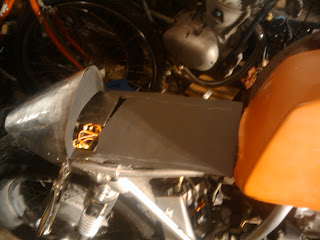The seat was a little stiff, obviously, so I got some foam padding at my local sewing shop. It was mildly expensive, at $70 per yard, but don't let them trick you into thinking you have to buy a whole yard, I only got 1/3rd of a yard, and had plenty left over.
I started by carving it into the same basic footprint as the seat pan.
And then I shaved the corners to start achieving the shape I want.
From there I found that the angle grinder works quite well at shaping the foam quickly and smoothly.
Be VERY careful if you choose to replicate this, as the grinder threw tons of foam dust, probably extremely cancerous, and it definitely sticks to clothing like you wouldn't believe.
After about 45 minutes of careful shaping I got a shape I was happy with.
I may still lower the padding a bit, it's quite tall.
The battery box was constructed of angle steel and steel plate, I think 1/8th inch.
Needs to be surface finished and painted.
Time to rule the world.



































